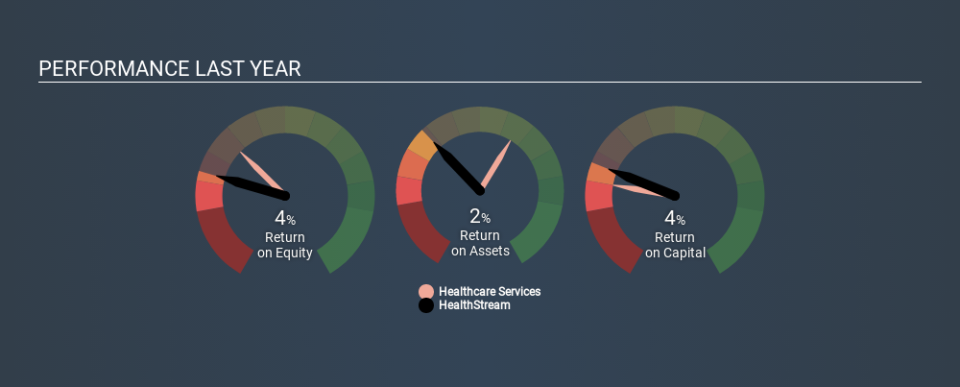Examining HealthStream, Inc.’s (NASDAQ:HSTM) Weak Return On Capital Employed

Today we are going to look at HealthStream, Inc. (NASDAQ:HSTM) to see whether it might be an attractive investment prospect. In particular, we'll consider its Return On Capital Employed (ROCE), as that can give us insight into how profitably the company is able to employ capital in its business.
First up, we'll look at what ROCE is and how we calculate it. Next, we'll compare it to others in its industry. Last but not least, we'll look at what impact its current liabilities have on its ROCE.
Understanding Return On Capital Employed (ROCE)
ROCE measures the 'return' (pre-tax profit) a company generates from capital employed in its business. Generally speaking a higher ROCE is better. Overall, it is a valuable metric that has its flaws. Author Edwin Whiting says to be careful when comparing the ROCE of different businesses, since 'No two businesses are exactly alike.
How Do You Calculate Return On Capital Employed?
The formula for calculating the return on capital employed is:
Return on Capital Employed = Earnings Before Interest and Tax (EBIT) ÷ (Total Assets - Current Liabilities)
Or for HealthStream:
0.038 = US$15m ÷ (US$490m - US$105m) (Based on the trailing twelve months to December 2019.)
Therefore, HealthStream has an ROCE of 3.8%.
View our latest analysis for HealthStream
Is HealthStream's ROCE Good?
ROCE is commonly used for comparing the performance of similar businesses. In this analysis, HealthStream's ROCE appears meaningfully below the 6.6% average reported by the Healthcare Services industry. This performance could be negative if sustained, as it suggests the business may underperform its industry. Independently of how HealthStream compares to its industry, its ROCE in absolute terms is low; especially compared to the ~1.7% available in government bonds. There are potentially more appealing investments elsewhere.
In our analysis, HealthStream's ROCE appears to be 3.8%, compared to 3 years ago, when its ROCE was 2.4%. This makes us think about whether the company has been reinvesting shrewdly. The image below shows how HealthStream's ROCE compares to its industry, and you can click it to see more detail on its past growth.
When considering ROCE, bear in mind that it reflects the past and does not necessarily predict the future. ROCE can be misleading for companies in cyclical industries, with returns looking impressive during the boom times, but very weak during the busts. ROCE is only a point-in-time measure. What happens in the future is pretty important for investors, so we have prepared a free report on analyst forecasts for HealthStream.
HealthStream's Current Liabilities And Their Impact On Its ROCE
Current liabilities include invoices, such as supplier payments, short-term debt, or a tax bill, that need to be paid within 12 months. Due to the way ROCE is calculated, a high level of current liabilities makes a company look as though it has less capital employed, and thus can (sometimes unfairly) boost the ROCE. To check the impact of this, we calculate if a company has high current liabilities relative to its total assets.
HealthStream has total assets of US$490m and current liabilities of US$105m. Therefore its current liabilities are equivalent to approximately 21% of its total assets. This is not a high level of current liabilities, which would not boost the ROCE by much.
What We Can Learn From HealthStream's ROCE
While that is good to see, HealthStream has a low ROCE and does not look attractive in this analysis. You might be able to find a better investment than HealthStream. If you want a selection of possible winners, check out this free list of interesting companies that trade on a P/E below 20 (but have proven they can grow earnings).
If you like to buy stocks alongside management, then you might just love this free list of companies. (Hint: insiders have been buying them).
If you spot an error that warrants correction, please contact the editor at editorial-team@simplywallst.com. This article by Simply Wall St is general in nature. It does not constitute a recommendation to buy or sell any stock, and does not take account of your objectives, or your financial situation. Simply Wall St has no position in the stocks mentioned.
We aim to bring you long-term focused research analysis driven by fundamental data. Note that our analysis may not factor in the latest price-sensitive company announcements or qualitative material. Thank you for reading.

